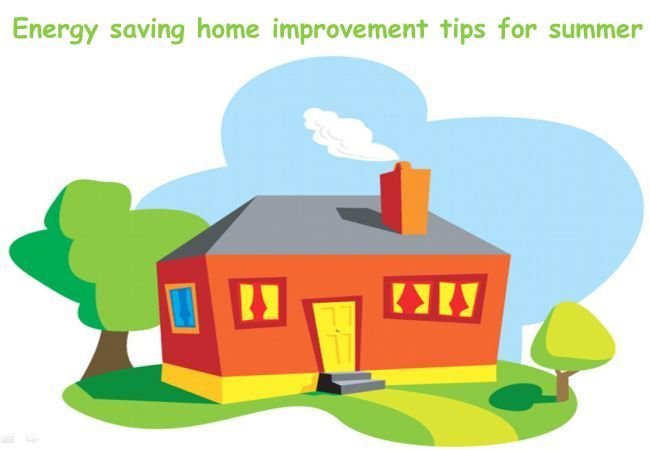Summer is coming! And that chimes the bell for Northern Hemispherians to get on with their home improvement projects in a rather speedy manner. Fortunately, there are some improvement endeavors that save energy while also contributing to the ‘cool’ side of affairs in the soul crushing summer seasons.
So, without further ado, let us take a quick gander at eight such energy saving home improvements that might just be effective for the coming hot months.

1) Take care of the cooling appliances –
It comes as no surprise that your air conditioner and refrigerator are the most crucial appliances in the summer time. Interestingly, they also work in a similar fashion by the exchange of heat through an array of coils that are filled with a specific refrigerant (cooling agent). So, it is always advised to clean these coils to maintain their effectiveness during the hot times.
You can simple clean your refrigerator’s backside coils with either a vacuum cleaner or a rag cloth. On the other hand, cleaning the air conditioner is a bit tricky, as you have to first open the casing and then dust off the coils (and the front filters) with brush and water sprays. However in both cases, be sure to turn off the power to the device.
2) Thermostats that can be programmed –
Partly related to our first tip, a programmable thermostat is quite effective in streamlining your interior’s temperature distribution, which can be pretty crucial during summer months. In fact, according to Energy Star, users can save up to a whopping $150 in energy costs per year by using such advanced devices. Moreover, the programmable variety is generally more accurate in its readings than the regular thermostat.
3) Fiberglass insulation –
Insulation comes with the dual advantage that keeps your house cool in the summer, by shielding against outside hot airflow; and also keeps your house warm in the winter, by not letting the tepidly heated air inside escape out. When translated to figures, proper insulation can easily reduce heating and cooling costs by at least 20 percent.
And the best part is – an entire roll of fiberglass insulation (which is a polymer made from plastic matrix reinforced by very thin fibers of glass) only costs around $15.
4) Re-caulking your doors and windows –
Beyond insulation, there still might be some small fissures and cracks that perforate your window sash and door frames. This is mainly due to the compression of the caulk that occurs during the winter season due to coldness. But the problem is – these very same cracks invite minute gushes of hot wind during the summer that gradually heats up the room. So, it is always a good idea to re-caulk such affected areas around windows and doors. For more details on caulking and even changing the window sash, follow our tutorial.
5) Weather Stripping –
Drafts are pretty common and unfortunately energy wasting, especially in our kitchens and bedrooms. Once again, according to Energy Star, these small leaks can result in a startlingly high energy wastage of around 30 to 40 percent of total loss in both cooling and heating.
But the more surprising part is arguably the facile solution – which requires the homeowner to simply opt for weather stripping. The materials used for weather stripping can be easily purchased at home improvement stores for less than $10!
6) Alternatives to ‘energy intensive’ air conditioning –
Air conditioners might improve upon the scope of your room’s comfort level, but on the other hand, they can also turn out be power guzzling monsters that rampantly increase your energy bills. Consequently, one of the better alternatives to an air conditioner is a ceiling fan that can reduce your yearly bills by at least $15-20.
Furthermore, there are other feasible alternatives to using air conditioners, including geothermal heat pumps, passive architecture and even the ole way of drenching your curtains and drapes. For more info, you can refer to one of our earlier posts that covers the subject in a detailed manner.
7) LED lighting –
Yes, we know you have heard this before, and yet we would like to drive our point home with some statistical figures. In purely commercial terms, LEDs cost more initially than CFLs and incandescent lamps. But when the energy costs are estimated and calculated over a period of ten years (at the rate of 15 cents/kWh and 6 hours of usage per day), incandescent lamps can cost you over $197, as opposed to just around $33 for most LED brands.
Now, beyond the scope of energy efficiency, LEDs also have the benefits of lower carbon emission, greater lifetime, efficient sizing, shock resistance and focus-oriented illumination. And, as for immediate solution, start switching off your lights in rooms that are not being used, because more lighting could actually raise the temperature of an already heated environment.
8) Planting trees never goes out of vogue –
Our last tip doesn’t pertain to just home improvement, but rather encompasses the improvement of your entire home compound’s environment. To that end, planting trees and landscaping your gardens always alludes to foresight, especially since trees can significantly reduce the temperature of the micro-climate of your compound.
Moreover, deciduous trees have the wonderful capacity to have lush foliage during the summer time. So their ‘strategic’ plantations close to a room’s window can potentially result in shading from the hot, unforgiving sun. On the other hand, during winter, the leaves of such tree types are shed, which allows a free passage of warm sunlight into your presumably cold room.



